 |  |  |
| Romanian Army in the Second World War · Forum Guidelines |
 Help Help
 Search Search
 Members Members
 Calendar Calendar
|
| Welcome Guest ( Log In | Register ) | Resend Validation Email |
| Pages: (4) 1 2 [3] 4 ( Go to first unread post ) |    |
| Florin |
Posted: October 22, 2004 12:55 am
|
|
General de corp de armata Group: Members Posts: 1879 Member No.: 17 Joined: June 22, 2003 |
Translation from: Realitatea Ilustrata (The Illustrated Reality), year XIII, no. 646, 6th of June, 1939
AIRPLANE FACTORY... In the Spring of 1911, Nicolae Filipescu, the Minister of War, ordered to the Chitila airport the first airplanes for the Army. With this occasion the first military school for pilots was founded. The workshops in Chitila produced four airplanes, which took part to the maneuvers in 1911. Also in 1911, Prince Bibescu had a school for pilots in Cotroceni, which produced the world famous pilots Nicu Capsa and Mihail Zorileanu, who also took part in the maneuvers. One of the airplanes built in Chitila was carried in flight by the young pilot Poly Vacas to Roman, were the maneuvers proceeded. This plane realized a record for that era: the sixth flight in the world over 400 km. As new orders failed to materialize, the workshops in Chitila ended their activity and they were closed. ***end of translation*** NOTE: We can read in "The Almanac of The Universe Newspaper", issued at the end of 1914 (third post under this topic): Romania owns today more than 50 airplanes of various types and power. But above, in this text about 1911, we learn that: As new orders failed to materialize, the workshops in Chitila ended their activity and they were closed. So after ordering just 4 airplanes, which behaved very well, our Department of War did not encourage our design and research potential by giving full support to Aurel Vlaicu (who in Germany refused an offer from Opel to become their technical director, just for the dream of doing something for Romania). Our Department of War did not call Henri Coanda from the United Kingdom (where he was technical director of the Bristol Airplane Factory, even though he was still in his 20’s), for the same goal of establishing our own research and design. Our Department of War decided to buy from abroad. This kind of story sounds so familiar... This post has been edited by Florin on October 24, 2004 04:31 am Attached Image 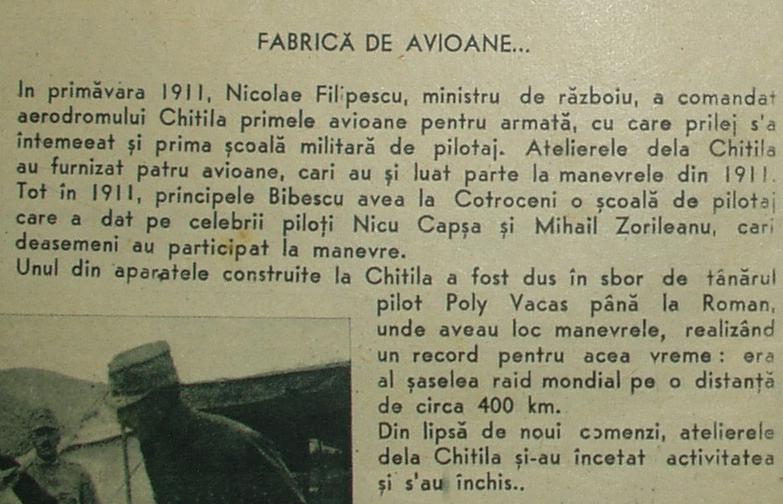 |
| Florin |
Posted: October 22, 2004 01:40 am
|
|
General de corp de armata Group: Members Posts: 1879 Member No.: 17 Joined: June 22, 2003 |
Photo from: Realitatea Ilustrata (The Illustrated Reality), year XIII, no. 646, 6th of June, 1939
Translation: This was the look of the "Farman" airplane used by the pilot Poly Vacas - 18 years old – to perform in 1911 the flight Bucharest - Roman, at the royal maneuvers. And the pilots did not catch cold... This post has been edited by Florin on October 23, 2004 01:42 am Attached Image 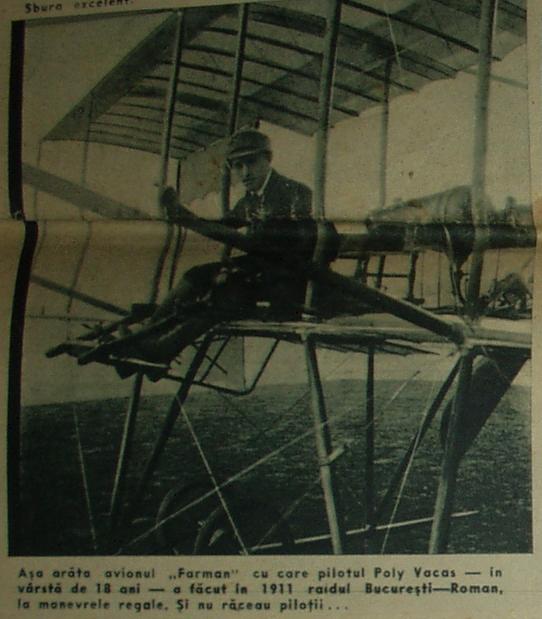 |
| Florin |
Posted: December 10, 2004 06:07 pm
|
|
General de corp de armata Group: Members Posts: 1879 Member No.: 17 Joined: June 22, 2003 |
Translation:
1913: The aviation school from Cotroceni, during summer: N.C.O. Dumitrescu, N.C.O. Bucur (deceased), Lieutenant Bertea, Sub-Lieutenant Ovidiu Ratescu, Lieutenant Giossanu, Captain Eugen Adamovici, Lieutenant Athanase Enescu, Lieutenant Beroniade, Sub-Lieutenant Stefan Alexandrescu, Lieutenant Sever Pleniceanu, the English mechanic Mac Intoche, the Russian mechanic Nikita Pascheff, Lieutenant Stefan Protopopescu and Lieutenant Alexandreanu. Photography from: Realitatea Ilustrata (The Illustrated Reality), year XIII, no. 646, 6th of June, 1939 Notes: 1. Few officers are also shown in the photo reproduced from The Almanac of The Universe Newspaper, issued at the end of 1914. But many other people are different. 2. I guess what the Romanian author mentioned as "the English mechanic Mac Intoche" was actually a Scotchman named McIntosh. This post has been edited by Florin on December 11, 2004 01:02 am Attached Image 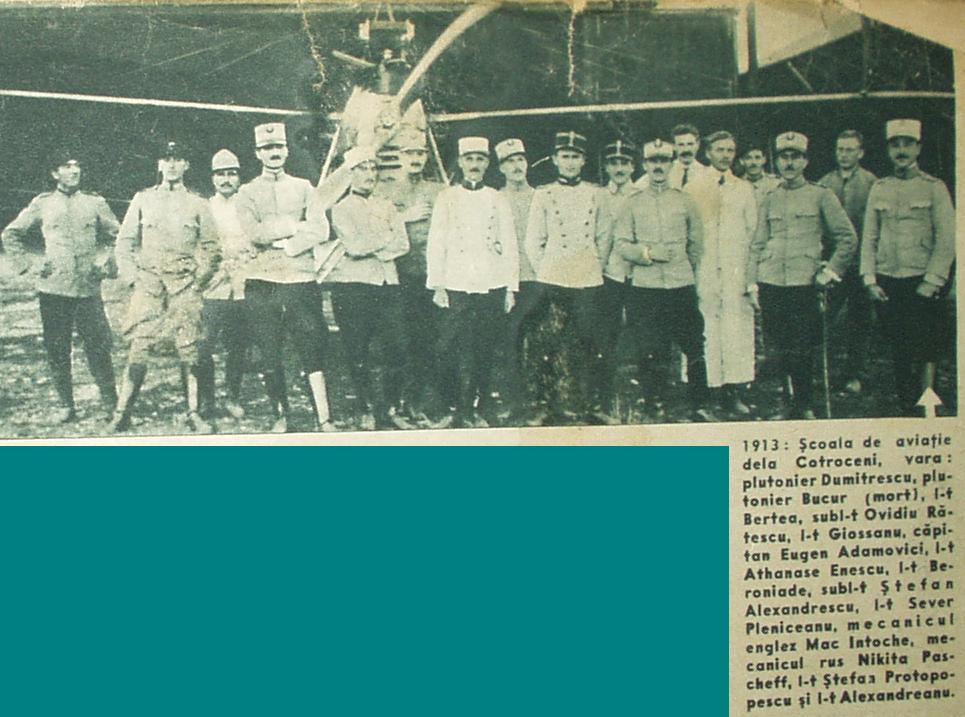 |
| Florin |
Posted: December 14, 2004 02:31 pm
|
|
General de corp de armata Group: Members Posts: 1879 Member No.: 17 Joined: June 22, 2003 |
Translation:
On the Cotroceni airfield, in year 1912: H. M. Prince Carol is looking to the flights. Near His Majesty there is the English pilot Dickens, who had his spinal column broken and then healed. In the second row, Prince Şerban Cantacuzino, a civil pilot. Photography from: Realitatea Ilustrata (The Illustrated Reality), year XIII, no. 646, 6th of June, 1939 Note: Beyond the officer staying in the 3rd row, the tip of an airplane wing can be seen. This post has been edited by Florin on December 14, 2004 02:38 pm Attached Image 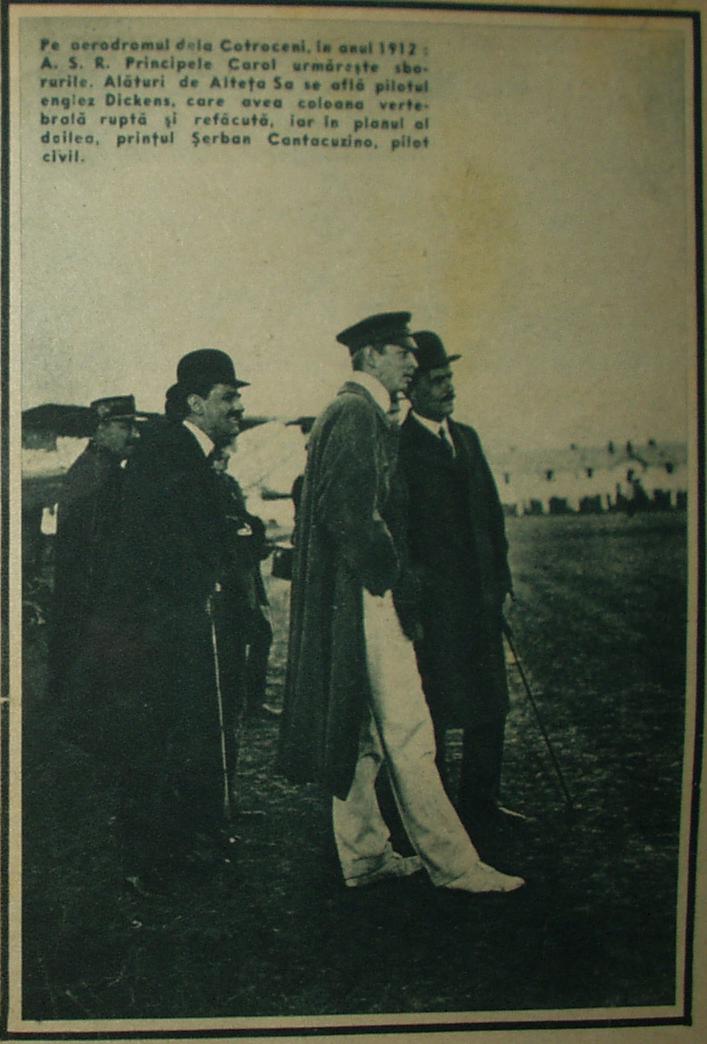 |
| Florin |
Posted: January 21, 2005 04:48 am
|
|
General de corp de armata Group: Members Posts: 1879 Member No.: 17 Joined: June 22, 2003 |
THE ROMANIAN AVIATION IN THE CAMPAIGN OF 1913
For the purpose of crossing Danube to Bulgaria, the two aviations, from Cotroceni and Baneasa, were organized in 2 sections and were distributed to the operational armies. As members of the first section was Lieutenant Aviator Protopopescu Şt., who piloted an airplane H. Farman and the Lieutenant Negrescu Gh., with a Bristol-Coanda monoplane. In addition to these pilots was also flying our great inventor and aviator Vlaicu, who registered himself as volunteer in the ranks of the Army, for the whole period of the campaign. The second aviation section was composed from the pilots and the airplanes of the Aerial League, which offered to the army 12 war airplanes, the last model, and eight excellent aviators: The Captains Fotescu C. and Sturza Al., Lieutenants Capşa N. and Mavrody, Sub-Lieutenants Mihăilescu, Vary and Macavei, and the volunteer Poly Vacas. The First Aviation Squadron, commended by the Captain (reserve) Gh. Bibescu, distinguish itself through outstanding reconnaissance. For its services, it was appraised with Order of the Day by the First Army Corps. The young aviation, through successful reconnaissance, brings real services to the Army, enlightening it. Even from the beginning of the operations, at Calafat, captain Fotescu C-tin, having as observer the Captain (reserve) I. Aryon, cross Danube and operate one reconnaissance towards Belogragic. During one attempt to cross Danube for another reconnaissance, these two pilots had to suffer a serious accident because of the currents. Captain Aviator Fotescu C-tin got severe burns on his face and on his body, as the apparatus was engulfed in flames. For his determined behavior and for his services, Captain Fotescu was decorated with Military Virtue for War. Lieutenant Capşa N., assisted by the Captain (reserve) I. Aryon, inform the commander of the First Cavalry Division, which was in action in the Obost Valley, towards Ferdinandov, about the existence of a Bulgarian infantry division, which later was captured. In the same reconnaissance actions successful attempts of aerial photography are made. Lieutenant Capşa N. explores in flight, at an altitude of 2600 meters, the Araba, Konach and Sarandi gorges. He was gliding with his airplane, marked with our tricolor, above the Bulgarian capital. He dropped, instead of bombs, a manifesto with the regards of the Romanian soldiers for the inhabitants of the city of Sofia. During the campaign in Bulgaria, pilot Poly Vacas crosses several times over the Balkan Mountains. *end of translation* Original text from: Realitatea Ilustrata (The Illustrated Reality), year XIII, no. 646, 6th of June, 1939 NOTES: 1. In the beginning of this topic I posted 2 original photos with the Romanian pilots during the campaign in Bulgaria. 2. With very deep regret I have to mention that a group photo with all the Romanian airplane pilots participating in the war with Bulgaria, including their mascot, the baby-sow Angela, is not in my possesion now, even though as a child I saw it in the house of my grandparents. I still hope that someday, somehow, I can see it again. This post has been edited by Florin on January 21, 2005 04:48 am Attached Image  |
| Florin |
Posted: January 21, 2005 05:06 pm
|
|
General de corp de armata Group: Members Posts: 1879 Member No.: 17 Joined: June 22, 2003 |
A group of aviators, "catched" – in 1913 – by our great painter Iser.
(From left to right): Lieutenant Nicu Capşa, Captain Andrei Popovici, Captain Mircea Zorilieanu, Captain Eugen Adamovici, Captain Alex. Sturza, Lieutenant Popovici (a friend of the group), Prince Valentin G. Bibescu, Captain Constantin Fotescu, Mihail Savu and Poly Vacas. Source: Realitatea Ilustrata (The Illustrated Reality), year XIII, no. 646, 6th of June, 1939 Attached Image 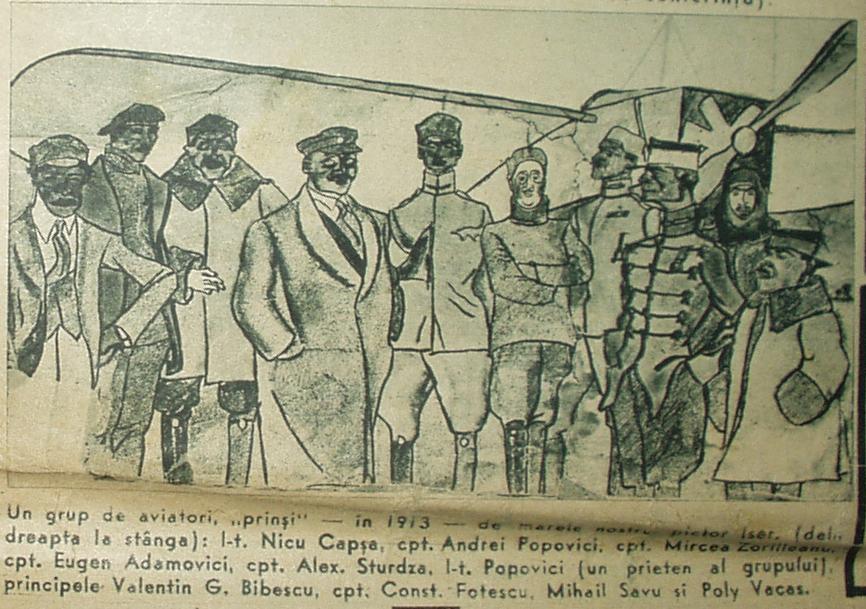 |
| Florin |
Posted: January 27, 2005 06:10 am
|
|
General de corp de armata Group: Members Posts: 1879 Member No.: 17 Joined: June 22, 2003 |
A merry group, in 1913:
Sitting, from right to left: Captain Eugen Adamovici, Lieutenant Radulian, Captain Andrei Popovici, Captain Al. Sturza. Standing, also from right to left: Captain Const. Fotescu, Captain Ion Popovici, Lieutenant Nicu Capşa, the French aviator Simon, Captain Mircea Zorilleanu and a French mechanic. Source: Realitatea Ilustrata (The Illustrated Reality), year XIII, no. 646, 6th of June, 1939 NOTE: 3 of the officers in the photo were mentioned as aviators in the article I posted before about the campaign in Bulgaria. As a reminder, Captain Const. Fotescu endured severe burns while succeeding to land with his plane engulfed by flames. Succeeding the landing saved the life of the pilot and of the other member of the crew, Captain (reserve) I. Aryon. This post has been edited by Florin on January 27, 2005 06:14 am Attached Image 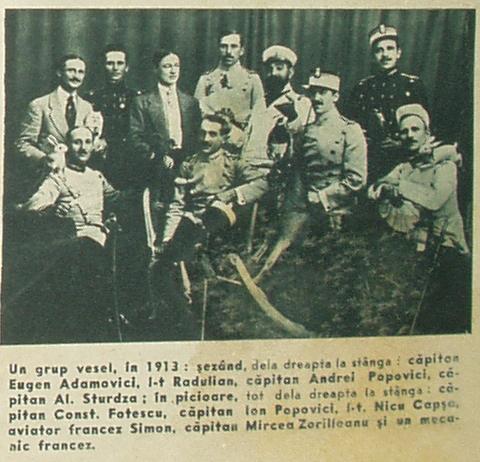 |
| Florin |
Posted: February 03, 2005 05:13 am
|
|
General de corp de armata Group: Members Posts: 1879 Member No.: 17 Joined: June 22, 2003 |
Translation:
The hangars from Băneasa, in 1912. In front of the hangars two airplanes can be seen: "Bleriot" of 80 HP, piloted by Nicu Capşa, and "Maurice Farman", nicknamed "Taxi-cab", piloted by Poly Vacas. Photography from: Realitatea Ilustrata (The Illustrated Reality), year XIII, no. 646, 6th of June, 1939 Notes: Beyond the farther wing tip of the Bleriot monoplane, you can see the Farman biplane. Whatever the reasons of painting the big circles on the wings of the Bleriot plane, they make the wings resembling with the wings of the Japanese planes which filled the Pacific skies 30 years later. This post has been edited by Florin on February 03, 2005 05:28 am Attached Image 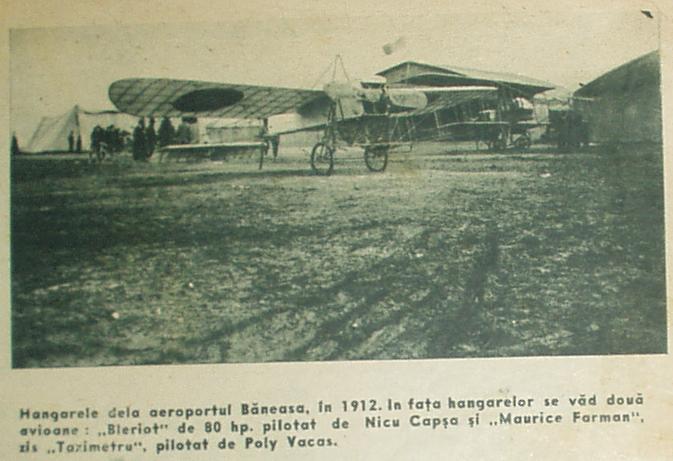 |
| Florin |
Posted: March 19, 2005 03:16 am
|
|
General de corp de armata Group: Members Posts: 1879 Member No.: 17 Joined: June 22, 2003 |
Translation:
1913: Mr. Lieutenant Doctor Victor Anastasiu takes piloting lessons, being this way the first Romanian medic becoming pilot. Photography from: Realitatea Ilustrata (The Illustrated Reality), year XIII, no. 646, 6th of June, 1939 This post has been edited by Florin on March 19, 2005 03:17 am Attached Image 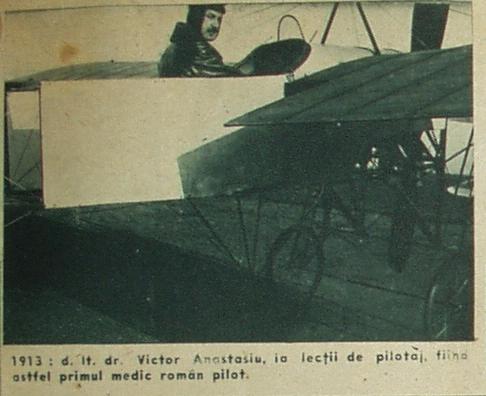 |
| Florin |
Posted: August 18, 2005 03:57 am
|
|
General de corp de armata Group: Members Posts: 1879 Member No.: 17 Joined: June 22, 2003 |
THE FLYING MEMBER OF PARLIAMENT…
We have to remember a pilot quite unusual: Mr. Nunucă Protopopescu, a big land owner in Oltenia, and member of the Parliament. In 1913 he obtained his pilot license at the Aerial League from Băneasa, having his own personal airplane and his own mechanics. In April 1914 he crashed at Mihăeşti (Vâlcea administrative county), having broken both legs. Nevertheless, he remained active in aviation, performing flights in the first part of the campaign of 1916. …AND THE FLYING MEDIC Another originality of our aviation: it had the second medic in the world who became a pilot. It is about Victor Anastasiu, MD, medic in aviation from 1913, then pilot in training in 1914 and licensed as pilot in March 1916. He performed his military duty, during the campaign, as pilot. Today he is commander, and the leader of the medical service of the aviation, which is enlisting about 80 medicine doctors. He is the author of many books regarding medicine in aviation. NOTES: 1. “Today” in the above text means June 1939. 2. The mentioning that the Romanian Royal Air Force had on a permanent basis 80 medicine doctors employed in June 1939 gives to us, from an interesting point of view, an idea about the strength of our military aviation in June 1939. From: Realitatea Ilustrata (The Illustrated Reality), year XIII, no. 646, 6th of June, 1939  This post has been edited by Florin on August 18, 2005 04:00 am |
| Florin |
Posted: August 18, 2005 04:34 am
|
|
General de corp de armata Group: Members Posts: 1879 Member No.: 17 Joined: June 22, 2003 |
A more accurate medical examination of the candidates willing to become pilots started in our country in 1914. A special attention was given to check the blood pressure. But as the medical pressure gauges were not available, here we can see in the photo how Lieutenant Medic Victor Anastasiu (also an aviator himself) is testing the blood pressure with what is accessible to him: the mercury-filled “Rivaroci” gauge, one of the first professional gauges of this kind.
Translation from: Realitatea Ilustrata (The Illustrated Reality), year XIII, no. 646, 6th of June, 1939  |
| Florin |
Posted: August 19, 2005 12:54 am
|
|
General de corp de armata Group: Members Posts: 1879 Member No.: 17 Joined: June 22, 2003 |
Regarding Mr. Nunucă Protopopescu, the member of the Parliament having his own personal airplane and his own mechanics, his story may lead to another interesting Romanian priority.
In the text from 1939, it is mentioned: "In April 1914 he crashed at Mihăeşti (Vâlcea administrative county), having broken both legs. Nevertheless, he remained active in aviation, performing flights in the first part of the campaign of 1916." It would be interesting to check, if possible, if there were any German, French, British or Russian pilot flying in 1914...1916 with their legs amputated. However, there is still room for argument, as in the original article (in the photo above) it is mentioned vaguely that the legs of the pilot were "broken". This cannot be exploited to mean "amputation", and maybe his legs healed somehow in time. Unfortunately, the lack of information cannot help for another priority: the first pilot to perform a military campaign with amputated legs. |
| Florin |
Posted: August 20, 2005 04:11 am
|
|
General de corp de armata Group: Members Posts: 1879 Member No.: 17 Joined: June 22, 2003 |
 Left photo: Victor Anastasiu, MD in 1913…1914, when he was Lieutenant Medic (the second medic in the world to become an airplane pilot) Right photo: Victor Anastasiu, MD in 1939, when he was Commander, chief of the medical services of the Romanian Royal Air Force This post has been edited by Florin on August 21, 2005 01:49 am |
| Florin |
Posted: August 20, 2005 09:54 pm
|
|
General de corp de armata Group: Members Posts: 1879 Member No.: 17 Joined: June 22, 2003 |
Supposing, in theory, that somebody does not now:
The newly introduced photos, the little ones as Internet links, need a "Click" with the left button of the mouse, to see the image at real size. This post has been edited by Florin on August 20, 2005 09:55 pm |
| Florin |
Posted: August 21, 2005 01:45 am
|
|
General de corp de armata Group: Members Posts: 1879 Member No.: 17 Joined: June 22, 2003 |
 Left photo: Fotescu Constantin in 1913, when he was Captain and one of the first pilots in the world to perform military flights during a war. Even from the beginning of the operations which started the war with Bulgaria in 1913, at Calafat, captain Fotescu C-tin, having as observer the Captain (reserve) I. Aryon, cross Danube and operate one reconnaissance towards Belogragic. During one attempt to cross Danube for another reconnaissance, these two pilots had to suffer a serious accident because of the currents. Captain Aviator Fotescu C-tin got severe burns on his face and on his body, as the apparatus was engulfed in flames. For his determined behavior and for his services, Captain Fotescu was decorated with Military Virtue for War. Right photo: Fotescu Constantin in June 1939, when he was General. Photos from: Realitatea Ilustrata (The Illustrated Reality), year XIII, no. 646, 6th of June, 1939 This post has been edited by Florin on August 21, 2005 01:50 am |
1 User(s) are reading this topic (1 Guests and 0 Anonymous Users)
0 Members:
 Pages: (4) 1 2 [3] 4
Pages: (4) 1 2 [3] 4 |
   |
[ Script Execution time: 0.0112 ] [ 15 queries used ] [ GZIP Enabled ]
Powered by Invision Power Board(U) v1.3.1 Final © 2003 IPS, Inc.



